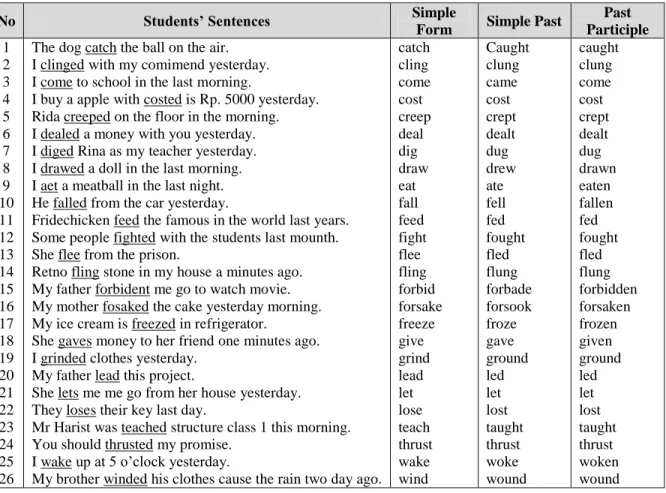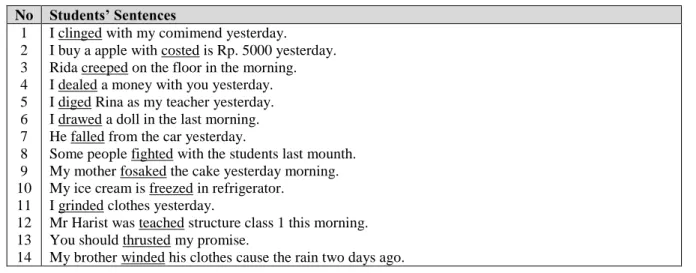The interaction patterns were produced based on teacher and student(s) and/or student(s) and student(s) in relation to the teacher conversation and students' conversation categories used during learning activities. The patterns of interaction that occurred in the first observation were cross-answering, closed-ended teacher questions (IRF), collaboration, and student-initiated-teacher-responses. Meanwhile, the interaction patterns in the second observation were group work, cross-answer, closed teacher questions (IRF), individual work, student-initiated-teacher responses, and open-ended teacher questions.
This pattern occurred when T2 greeted the students at the beginning of the lesson and the students greeted the teacher back. Meanwhile, the interaction patterns in the second observation are choral responses, open-ended teacher questioning, individual work, student initiatives-teacher responses, and closed-ended teacher questioning (IRF). This pattern occurred; for example, when the teacher asks the students to do the exercise from the book.
Improving the Students’ Listening Comprehension through Drill Technique
Wirathama Hazera Putra
The pre-test was administered before the treatment of teaching listening comprehension through drill technique was implemented, to see the students' basic listening comprehension. The post-test was then administered, to analyze the improvement in students' listening comprehension through the coaching technique. The result of the research showed that students' listening comprehension improved after they were taught through drill technique in Grade 7 RSBI 2 of SMPN 2 Bandar Lampung.
Based on the findings, it can be seen from the students' mean scores of the pre- and post-test that there was a significant improvement before and after the teaching through drill technique. Specifically, the drilling technique improved students' listening comprehension in all aspects of microskill types of listening comprehension, such as recognizing intonation pattern, recognizing sentence pattern, recognizing discourse marker, and getting the reference information. In addition, the drill technique mostly improved the students' listening comprehension in recognizing intonation patterns, where their ability in that aspect was 38% significantly improved.
In addition to that, based on the result of observation and interview, the problems students face in learning listening comprehension microskills through drilling technique were found. Lack of listening practice can lead to students not being able to keep up with the speed of the native speaker. It was proved by the increase in the average score of the students in the post-test, which was higher than in the pre-test.
Specifically, the drill technique improved students' listening comprehension in all aspects of the types of listening comprehension microskills, such as intonation pattern recognition, sentence pattern recognition, discourse marker recognition, and referential information retrieval. There were some problems faced by the students in learning the micro skills of listening comprehension through drill technique.
An Analysis of Omission in Students’ English Writings
Ingatan Gulö 1 , Teo Vany Rahmawelly 2
Berkham (2015) states that the subject of a sentence is the noun that corresponds to the verb in the sentence. In these data, the verb is plural and needs to add -s to the end of it making it supportive in order to agree with the previous subject. In the third case it is the same as the others; it needs the ending -es to match the rule.
These data show that students tend to omit verbal suffixes, causing the verbs to not match the subjects in the sentences. Based on the examples above, the omission of the suffix -s is very common in the data. It must be in the third person singular form with the ending -es, so the verb to cry is not to cry.
Another very common error occurs in the last base as the verb go is in the incorrect form. Compared to those of the first group in 1-3, the sentences of the second are grammatically more complicated. In the following data, for example, the main verbs are present, but the auxiliary verbs are not.
All of the main verbs above are not in the correct forms of the English grammatical structure. The most common omissions found in the data are related to the verb markers -s and -es, verbs, auxiliaries and the -ing form.
L2 Acquisition Portrayed through the Use of Way Ahead Game by Children in Learning Basic English
Angga Apresa Nuryasin
The results of the interviews about the students' opinion about playing games as a tool for learning English as their second language are in the following:. Mubaslat, 2011: The effect of using educational games on the students' achievement in English language for the primary stage). Finally, the third question was asked to the students related to their opinion on the use of the Way Ahead game in learning.
The question is based on Mubaslat (2011) in her research; The effect of using educational games on students' achievements in the English language for the primary stage. The Way Ahead game can be used as an effective method by teachers to maximize students. Furthermore, it is believed to be an effective teaching method for teachers who are able to relate the game to the learning environment of students who need to understand English.
The students were asked to play the game before the teacher moved on to the real discussions. As a result, the students had fun, who then learned the next lesson with interest. The materials in the Way Ahead game match the materials that the teachers will give to the students.
The role of the Way Ahead game has been found to be functional for students in learning basic English. The effect of using educational games on students' performance in English language for the primary stage.
Undergraduates’ Awareness of English Irregular Verbs
Harits Setyawan
Identify Subsections
English had been taught to the students since they were in junior high school, and English irregular verbs was one of the topics they taught them during the time. In conducting this research, the researcher followed some procedures: (a) construction of the task, (b) determination of the samples, (c) collection of data, (d) selection of data and (e) analysis of data. After the data collection instruments were constructed, the researcher came to the site of the research to collect the data.
When the data had been collected, the data were selected and only errors in the use of irregular verbs were obtained.
Participant Characteristics
Sampling Procedures
- Sample Size, Power, and Precision
- Measures and Covariates
- Research Design
- Experimental Manipulations or Interventions
The following table shows the common mistakes the students made when using irregular verbs in their sentences. Low awareness of English irregular verbs in students can be caused by many factors; both internal factors that come from the students themselves and external factors that come from teachers, curricula, tests, etc. After distinguishing between the students' errors in using English irregular verbs, the researcher found that there were three types of errors were when using English irregular verbs.
The following table shows mistakes made by the students by applying English regular verb rule to English irregular verb. Furthermore, the researcher found that the second highest percentage of errors made by the students when using English irregular verbs was the use of simple form verbs to tell about past events. The following table shows the sentences that used English simple form verbs, although the students had previously been instructed to write sentences that told about past events.
This type of error may have occurred because the students did not know that they had to change simple past English verbs into simple past English verbs when telling about past events. The following table shows the mistakes the students made when they changed English irregular verbs into new forms of verbs that did not exist in the English vocabulary. Similar to the first type of error that the researcher found, the third type of error may have occurred because the students realized that the verbs given to them must have been changed to simple past forms in sentences that tell of past events.
It can be seen from the third type of errors where students wrote aet, stop and give. Furthermore, the mistakes students made when using English irregular verbs can be classified into three types: (a) using the regular verb rule for the irregular verb, (b) using the simple form verb for the past event and (c) creating new words that do not exist.

Maintenance of Lampung Language in Padang Cermin District
Citra Wulandari
Most of Padang Cermin society use their mother tongue which is Lampung language while their second language is Indonesian language. The next raises several research questions related to (1) the domains that the Lampung language is used by the Padang Cermin society, (2) the factors leading to language maintenance and language change, and (3) the attitude of the Padang Cermin society towards the Lampung language. Meanwhile, the transaction domain is a plural domain, so most adult respondents use Indonesian mixed with Lampung.
From the table above, it shows that Lampung Language is mostly used as the dominant language in Padang Cermin followed by Indonesian Language and Mixed Language. The researchers found that the level of maintenance of the Lampung language when speaking with the elderly or peers tends to be high, but not with younger ones. The outdoor activities experienced by some of the teenagers surveyed also make the maintenance level of Lampung Language lower.
Thus, the economic development in the area inhabited by the speaker affects their maintenance of Lampung language level. The lack of strength in maintaining Lampung language can also be seen from the efforts of language and cultural heritage of their children. The researchers also find out how the attitude of language among people who speak Lampung Language.
On the other hand, the majority seems to have a positive attitude towards the Lampung language. Third, the language attitude affects the level of Lampung Language Maintenance in Padang Cermin District.





